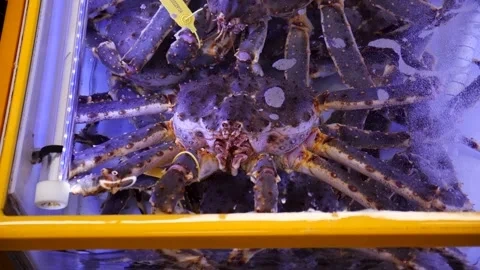Origin of the Name of the Red King Crab
The scientific name of the Red King Crab is the Paralithodes camtschaticus. The Red King Crab is the representative species of the king crabs also known as the Kamchatka crab named after the Kamchatka peninsula near Russia or the Alaska King Crab named after Alaska.
The red king crab is called tarbagani タラバガニ in Japanese and called (적색) 왕게 in Korean.


The red color gave the name “Red King Crab”, however the red king crab has a rather burgundy color and many other king crabs have a red color as well. It is difficult to tell apart different king crab species with their color when they are cooked.
All crabs and other crustaceans turn red when they are cooked or heated due to the Chitin in the shells of crustaceans.



Size and Habitat of the Red King Crab
The Red King Crab tends to grow the largest among the other king crab species. A Red King Crab could grow up to 12.7kg about 28 pounds, however commercially fished red king crab typically are the weight between 1.8kg ~ 3.6kg about 4 pounds to 8 pounds.
The Red King Crab is native to the Northern Pacific Ocean including the Bering Sea. Red King Crab are native in the coasts of Alaska and the Bering Sea in the U.S.A, Kamchatka Peninsula and the Okhotsk Sea of Russia and the waters of Japan.



However, the Soviet Union introduced the red king crabs to the Murmansk region of Russia in the oceans of northern Russia.
These red king crabs migrated west and became an invasive species in Norway and even settled in the Barents Sea. Red king crabs live in waters with a −1.8 to 12.8 °C (28.8–55.0 °F) temperature range and tend to live in muddy or sandy regions. Red king crabs are caught in depths of 20~200 meters(66~656 feet).




Invasive Species of the Barents Sea and Norway – Red King Crab
Red King Crab have high market value and the Soviet Union attempted to create a new commercial fishing ground for Red King Crabs in the Murmansk region.
In 1960, the Soviet Union successfully released red king crabs in the Murmansk region, however after about 10 years, the Norway government discovers invasive red king crab species in the Barents Sea.
The red king crab from Murmansk eventually migrated and adapted to the waters of Norway in the Barents Sea. The red king crab species had no natural predators in the oceans of Norway and became an ecological hazard.


The Norwegian government referred these red king crabs “Stalin’s crabs”. Red king crab did become a commercially prized seafood for Norway, however as an invasive species, in the free waters of Norway as of 2025, it is illegal to release red king crab.
It is ironic as the native habitats of red king crabs have a strict fishing size limit and even ban fishing of female red king crabs.
Red King Crab fishing in Norway is only banned in April because of the molting season. Possibly the objective is not to preserve the red king crabs but to increase the market value as much as possible.




Commercial fishing of red king crab
It may differ per region; however the fishing season of the red king crab is usually between October and January as the molting season and mating season of the red king crab is between March and June. The fishing seasons of the red king crab is controlled by the government.
For example, due to the population decrease of the red king crab, the United States of America government has shutdown the fishing permit of red king crab in Alaska several years.




Red King Crab – Highest market value
Among all the king crab species, the red king crab has the highest market value and is a prized ingredient in many countries for its flavor and higher meat yield in the carcass and legs.
Also, the red king crab has a relatively thinner shell and larger legs so per the same weight, red king crab has the highest meat yield. The high market value made red king crabs a valuable asset that requires finesse population control.




Origin of the Name of the Blue King Crab
The Blue King Crab is another delicacy of the sea. The name Blue King Crab comes from the blue color patterns that are notable on the claws of the blue king crab.
The blue king crab also has a reddish color but by looking from the top, the blue king crab has a more blue color on its body especially on the claws. The scientific name of the blue king crab is Paralithodes platypus, and it is called 청색 왕게 in Korean while it is called アブラガニ Abragani in Japanese.




Size and Habitat of the Blue King Crab
The Blue King Crab is native to the Northern Pacific Ocean like the red king crab where it would live along the stirp connected from Alaska, the Kamchatka peninsula of Russia over to the Sea of Okhotsk.
The blue king crabs tend to live in much lower temperature than its similar counterparts, the red king crabs. The blue king crabs tend to live in depths from 70 m~180 m(230feet ~ 590 feet)




Commercial fishing of blue king crab
The fishing season of blue king crab is usually between October and January similar to the red king crab. The mating season and the molting season of the blue king crab is around late March to April and its fishing season is also controlled by the government.
Blue king crab also has high commercial value, however it is cheaper than the red king crab as the blue king crab has a thicker shell and relatively thinner legs compared with the red king crab.







